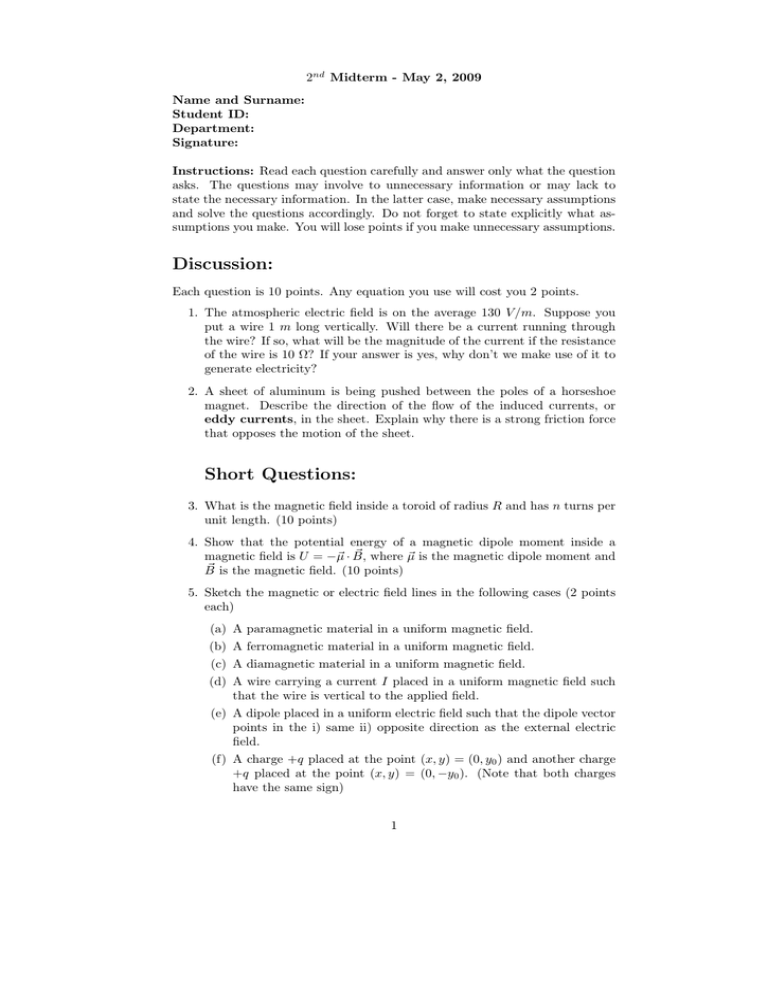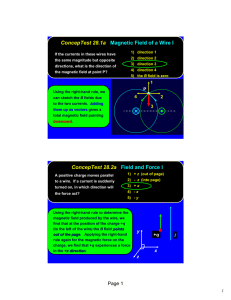2 nd Midterm
advertisement

2nd Midterm - May 2, 2009 Name and Surname: Student ID: Department: Signature: Instructions: Read each question carefully and answer only what the question asks. The questions may involve to unnecessary information or may lack to state the necessary information. In the latter case, make necessary assumptions and solve the questions accordingly. Do not forget to state explicitly what assumptions you make. You will lose points if you make unnecessary assumptions. Discussion: Each question is 10 points. Any equation you use will cost you 2 points. 1. The atmospheric electric field is on the average 130 V /m. Suppose you put a wire 1 m long vertically. Will there be a current running through the wire? If so, what will be the magnitude of the current if the resistance of the wire is 10 Ω? If your answer is yes, why don’t we make use of it to generate electricity? 2. A sheet of aluminum is being pushed between the poles of a horseshoe magnet. Describe the direction of the flow of the induced currents, or eddy currents, in the sheet. Explain why there is a strong friction force that opposes the motion of the sheet. Short Questions: 3. What is the magnetic field inside a toroid of radius R and has n turns per unit length. (10 points) 4. Show that the potential energy of a magnetic dipole moment inside a ~ where µ magnetic field is U = −~ µ · B, ~ is the magnetic dipole moment and ~ B is the magnetic field. (10 points) 5. Sketch the magnetic or electric field lines in the following cases (2 points each) (a) (b) (c) (d) A paramagnetic material in a uniform magnetic field. A ferromagnetic material in a uniform magnetic field. A diamagnetic material in a uniform magnetic field. A wire carrying a current I placed in a uniform magnetic field such that the wire is vertical to the applied field. (e) A dipole placed in a uniform electric field such that the dipole vector points in the i) same ii) opposite direction as the external electric field. (f) A charge +q placed at the point (x, y) = (0, y0 ) and another charge +q placed at the point (x, y) = (0, −y0 ). (Note that both charges have the same sign) 1 Calculations: Instructions: In this part, your solution should include 3 parts: In the 1st part, explain what you understand the question asks. In the 2nd part, explain your strategy in solving the problem. In the 3rd part, solve the problem. If you skip any of the parts, the rest of your answer will not be considered for grading. 6. Consider a wire bent at right angles. Assume that the corner is placed at the origin and the sides are on the positive x and y axis. Calculate the magnetic field at an arbitrary point (x0 > 0, y0 > 0) if there is a current in the wire which arrives at the origin from the yaxis and leaves the origin along the x axis. (20 points) 7. Consider a transformer whose primary coil is attached to an alternating emf source which can be written as E = Emax cos ωt. The secondary coil is attached to a resistor of resistance r. If the ratio of the turns of the primary and secondary coil is R, what is the average input power? output power? (20 points) 8. Consider a circuit in the shape of a square of side length L. The circuit consists of only a capacitor of capacitance C and the ends of the capacitor are connected by a resistanceless wire. If initially the capacitor carries a charge Q0 , what is the time dependent current in the wire? (Hint: The circuit has a self inductance due to its shape. In calculating the self inductance, ignore the effect of the capacitor). (20 points) Some numerical coefficients: e = 1 4π0 µ0 4π Coulomb Law: F~ E = 1.6 × 10−19 C = 9.0 × 109 N m2 /C 2 = 10−7 N/A2 0 1 qq 4π0 r 2 r̂ Magnetic force between two moving particles: F~M = ~ = 0 I2 d~l × r̂ Biot-Savart Law: dB 4π r H ~ · dS ~=Q Gauss’ Law: E H ~ · d~l = µ0 I + µ0 0 dΦE Faraday’s Law: B dt H ~ · d~l = − dΦB , E dt H ~ · dS ~=0 B 2 (1) µ0 qq 0 v 4π r 2 ~ × (~v 0 × r̂)




